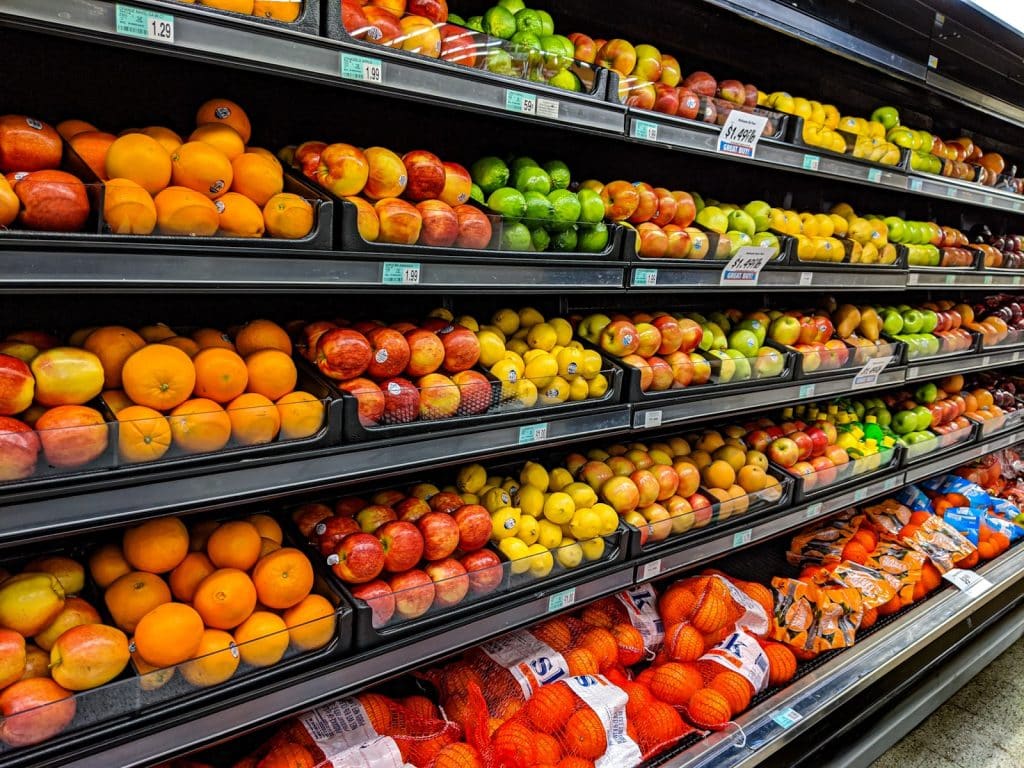Are you tired of feeling like you’re constantly emptying your wallet at the grocery store? Well, fear not! There’s an old saying that goes, ‘A penny saved is a penny earned,’and we’re here to help you save those pennies. In this article, we will explore strategies for saving money on groceries specifically tailored for large families like yours.
With these practical and knowledgeable tips, you’ll be able to stretch your budget further while still providing delicious and nutritious meals for your loved ones.
As a member of a large family, it’s natural to feel the pressure of making every dollar count. That’s why meal planning is essential in order to have cost-effective shopping trips. By carefully planning out your meals for the week, you can create a comprehensive grocery list that includes only the items you truly need. This not only avoids unnecessary impulse buys but also allows you to take advantage of sales and coupons.
Additionally, buying in bulk from warehouse clubs can significantly reduce costs over time. With these strategies in mind, you’ll find yourself with more money in your pocket without sacrificing the quality or variety of food that your family needs.
So let’s dive into these helpful tips together and start saving today!
Meal Planning for Cost-Effective Shopping
When meal planning for a big family, it’s essential to find ways to save money on groceries without compromising on deliciousness. One strategy is to plan your meals around items that are on sale or in season. This allows you to take advantage of lower prices and fresher produce.
Look for weekly flyers from grocery stores or sign up for their email newsletters to stay updated on the latest deals. By incorporating these sale items into your meal plan, you can create cost-effective and nutritious meals for your large family.
Another way to save money on groceries is by buying in bulk. Purchasing staple ingredients such as rice, pasta, beans, and canned goods in larger quantities can help reduce the overall cost per serving. Consider joining a warehouse club like Costco or Sam’s Club, where you can buy items in bulk at discounted prices. Additionally, buying in bulk reduces the number of shopping trips you need to make, saving you time and transportation costs.
Lastly, when meal planning for a large family, don’t forget about leftovers! Make extra portions during each meal so that there are leftovers for future meals. Leftovers can be repurposed into new dishes or simply reheated for an easy and budget-friendly lunch or dinner option. Get creative with how you use leftover ingredients by making casseroles, stir-fries, or soups. This not only saves money but also minimizes food waste.
By implementing these strategies into your meal planning routine, you can save money on groceries while still providing delicious meals for your big family. Planning meals around sales and seasonal produce ensures that you get the most value out of your purchases. Buying in bulk helps reduce costs per serving while also cutting down on shopping trips. And don’t forget about utilizing leftovers to stretch your budget even further. With these tips in mind, feeding a large family doesn’t have to break the bank!
Buying in Bulk and Taking Advantage of Warehouse Clubs
To save on groceries for your big family, try buying in bulk and taking advantage of warehouse clubs. Buying in bulk allows you to get more for your money and reduce the cost per unit. Warehouse clubs like Costco or Sam’s Club offer a wide variety of products at discounted prices, making it easier to stock up on essentials without breaking the bank.
Here are some benefits of buying in bulk and utilizing warehouse clubs:
-
Cost savings: Purchasing items in larger quantities often results in significant savings. By buying in bulk, you can take advantage of lower prices per unit, helping you save money over time.
-
Reduced trips to the store: Buying in bulk means you’ll have a surplus of essential items that will last longer. This reduces the number of trips you need to make to the grocery store, saving you both time and transportation costs.
-
Variety and convenience: Warehouse clubs offer a wide range of products, from groceries to household items. You can find everything your family needs under one roof, saving you from having to visit multiple stores.
-
Bulk packaging options: Many warehouse clubs provide large packaging sizes that aren’t typically available at regular grocery stores. This is especially beneficial for staple items like rice, pasta, or canned goods.
-
Membership perks: Warehouse club memberships often come with additional perks like discounts on gas or exclusive access to certain promotions. These extras can further enhance your savings and overall shopping experience.
By buying in bulk and taking advantage of warehouse clubs’ offerings, you can maximize your budget while ensuring your large family has all their needs met. Not only will this strategy help you save money on groceries, but it also provides a sense of belonging by enabling you to be part of a community focused on smart shopping practices.
Shopping at Farmers’ Markets for Fresh and Affordable Produce
By shopping at farmers’ markets, you can score fresh and affordable produce while supporting local growers and enjoying a vibrant community atmosphere.
Farmers’ markets are a great option for large families looking to save money on groceries. Not only do they offer a wide variety of fruits, vegetables, and other farm-fresh products, but the prices are often more affordable compared to grocery stores. This is because there are no middlemen involved in the process, allowing farmers to sell their goods directly to consumers at lower costs.
In addition to the cost savings, shopping at farmers’ markets also allows you to support local growers and businesses. When you buy from these markets, you are contributing directly to your community’s economy and helping small-scale farmers thrive. By purchasing locally grown produce, you are reducing the carbon footprint associated with long-distance transportation that is often required for grocery store produce. It’s a win-win situation – not only do you get fresh and affordable food, but you also play a part in creating a sustainable food system.
Furthermore, shopping at farmers’ markets provides an opportunity for connection and belonging. These markets often have a vibrant atmosphere with live music, food tastings, and community events. You can meet the people who grow your food and learn about their farming practices firsthand. This sense of community fosters a feeling of belonging as you become part of something bigger than yourself – a network of individuals who care about supporting local agriculture and enjoying quality produce together.
So why not give it a try? Visit your local farmers’ market next weekend and experience all the benefits it has to offer. You’ll not only save money on groceries for your large family but also enjoy fresh produce while supporting local growers and becoming part of an engaged community that values sustainable living and delicious food.
Utilizing Coupons and Sales to Maximize Savings
Maximizing your savings is like finding hidden treasure, and one way to do this is by utilizing coupons and taking advantage of sales.
Coupons are a great way to save money on groceries, especially when you have a large family to feed. Look for coupons in newspapers, magazines, and online coupon websites. Clip them out or print them off and keep them organized in a coupon binder or folder.
When you go grocery shopping, make sure to bring your coupons with you and use them on items that you would normally buy anyway.
Another strategy for saving money on groceries is to take advantage of sales. Keep an eye out for weekly ads from local grocery stores and plan your meals around what’s on sale. Buy items in bulk when they’re on sale so that you can stock up and save money in the long run.
Additionally, consider signing up for store loyalty programs or email newsletters as they often provide exclusive discounts or promotions.
By utilizing coupons and sales, you can significantly reduce your grocery bill each month. It may take some time and effort to find the best deals and clip coupons, but the savings will be well worth it.
Plus, when you see how much money you’re able to save each week, it can give you a sense of accomplishment and belonging to a community of savvy shoppers who are all working towards the same goal – saving as much money as possible while still providing nutritious meals for their families.
So don’t overlook the power of coupons and sales – they truly are hidden treasures waiting to be discovered!
Cooking from Scratch to Save on Pre-Packaged Foods
Cooking from scratch can be a game-changer for your budget, allowing you to save big on pre-packaged foods. By preparing meals using basic ingredients, you eliminate the added costs of packaging and processing. Not only will this help you save money, but it also gives you more control over the quality and nutritional value of your meals.
Plus, cooking from scratch can be a fun and rewarding way to bond with your family and create delicious homemade meals together.
When you cook from scratch, you have the flexibility to choose affordable ingredients that are in season or on sale. This means that you can take advantage of lower prices and stock up on pantry staples when they’re at their cheapest. Buying bulk quantities of items like rice, beans, pasta, flour, and spices can significantly reduce your grocery bill over time.
Additionally, by making large batches of meals and freezing leftovers, you can stretch your food budget even further.
Another benefit of cooking from scratch is that it allows you to avoid hidden costs associated with pre-packaged foods. Many processed products contain additives and preservatives that not only add to the price but may also have negative health effects in the long run. By preparing meals at home using fresh ingredients, you have full control over what goes into your dishes. You can choose healthier alternatives while saving money at the same time.
Cooking from scratch is an excellent strategy for saving money on groceries for a large family. It empowers you to make cost-effective choices by utilizing affordable ingredients and taking advantage of sales. Moreover, it allows for healthier meal options without compromising taste or variety.
So why not gather your family in the kitchen and start exploring delicious homemade recipes? Not only will it help tighten your budget but also create lasting memories together as a family unit.
Embracing Meatless Meals for Lower Grocery Costs
Try embracing meatless meals to discover a world of flavorful, budget-friendly dishes that will have your taste buds dancing and your wallet thanking you. Going meatless for some of your meals can be a great way to save money on groceries for your large family. Not only are vegetables, grains, and legumes typically less expensive than meat, but they also provide important nutrients and can be just as satisfying.
Here are five reasons why you should consider incorporating more meatless meals into your weekly menu:
-
Lower grocery costs: Meat is often one of the most expensive items in a grocery bill. By cutting back on or eliminating meat from some meals, you can significantly reduce your grocery expenses.
-
Health benefits: Plant-based meals tend to be lower in saturated fat and cholesterol while being higher in fiber and essential nutrients. This can lead to improved overall health and may even help prevent certain chronic diseases.
-
Variety: Embracing meatless meals encourages you to get creative with different ingredients and flavors. You’ll find yourself exploring new recipes, trying new vegetables, grains, and legumes that you may not have considered before.
-
Environmental impact: The production of meat takes a toll on the environment through increased greenhouse gas emissions, deforestation, water usage, and other factors. By opting for more plant-based meals, you can reduce your carbon footprint and contribute to a more sustainable food system.
-
Community support: Many communities have local farmers’ markets or co-op programs that offer affordable produce options. Supporting these initiatives not only helps you save money but also fosters a sense of belonging within your community.
By embracing meatless meals for lower grocery costs in your large family’s meal planning, you’ll not only save money but also enjoy delicious dishes that are good for both your budget and your health. Incorporate more vegetables, grains, legumes into each meal while exploring new recipes to keep things interesting. And don’t forget about the positive impact you’ll have on the environment and your community by supporting local farmers and reducing your carbon footprint. So go ahead, try out some meatless meals and discover a world of flavorful possibilities that will make both your taste buds and wallet happy.
Growing Your Own Fruits and Vegetables
You’ll love the satisfaction of growing your own delicious fruits and vegetables. Not only will you save money, but you’ll also have the peace of mind knowing exactly where your produce comes from.
Plus, there’s something incredibly rewarding about watching your plants grow and harvesting the fruits of your labor.
To start growing your own fruits and vegetables, consider what grows well in your climate and soil conditions. Some easy-to-grow options include tomatoes, cucumbers, peppers, lettuce, and herbs like basil and mint.
You can start small with a few pots on a balcony or create a larger garden in your backyard.
One of the biggest advantages of growing your own produce is that it allows you to control the quality of what you eat. You won’t have to worry about pesticides or other chemicals often used in commercial farming.
Additionally, by harvesting fresh fruits and vegetables straight from your garden, you can ensure maximum nutritional value for both yourself and your family.
So why not take advantage of nature’s bounty and enjoy the benefits of homegrown goodness?
Shopping with a Grocery List to Avoid Impulse Buys
Contrary to popular belief, shopping with a grocery list doesn’t necessarily guarantee that you’ll avoid those tempting impulse buys. While having a list can definitely help you stay focused and organized, it’s important to remember that discipline plays a big role in sticking to your budget.
When you see those flashy displays or enticing promotions, it’s easy to get lured into buying things that are not on your list. To combat this, try creating a meal plan for the week before making your grocery list. This way, you’ll have a clear idea of what ingredients you need and won’t be as easily swayed by those impulse purchases.
Another effective strategy is to shop with cash instead of using credit or debit cards. When you physically see the money leaving your wallet, it becomes more real and forces you to think twice about unnecessary purchases. Set a specific budget for groceries each week and withdraw that amount in cash before heading to the store. This will help you stay within your means and avoid overspending on items that aren’t essential.
Lastly, consider shopping alone whenever possible. Bringing children or other family members along can increase the chances of impulse buys as they may request items not on your list or be easily swayed by marketing tactics. Shopping alone allows you to focus solely on getting what’s necessary without any distractions or external influences. If taking someone along is unavoidable, communicate beforehand about sticking strictly to the grocery list.
By following these strategies, shopping with a grocery list can indeed help you save money on groceries for your large family. It provides structure and organization while reducing the likelihood of falling into impulsive spending habits. Remember to stay disciplined, shop with cash when feasible, and try shopping alone if possible. With these tips in mind, your trips to the grocery store will become more efficient and cost-effective in no time!
Comparing Prices and Shopping at Multiple Stores
Now that you’ve learned about the importance of shopping with a grocery list to avoid impulse buys, let’s move on to another effective strategy for saving money on groceries: comparing prices and shopping at multiple stores. By taking the time to compare prices and shop around at different stores, you can ensure that you’re getting the best deals and maximizing your savings.
One way to compare prices is by using online resources or apps that allow you to easily compare prices of different items across multiple stores. These tools can help you identify which store has the best price for a particular product, allowing you to make more informed decisions about where to shop. Additionally, consider checking out weekly flyers or advertisements from various grocery stores in your area. By comparing these ads, you can see which store offers the most competitive prices for the items on your shopping list.
Another approach is to strategically plan your shopping trips based on sales cycles. Many grocery stores have regular sales cycles where certain items are discounted during specific weeks or months. By knowing when these sales occur, you can time your purchases accordingly and stock up on items when they’re at their lowest prices. This requires some planning and organization, but it can lead to significant savings over time.
To help illustrate the potential savings from comparing prices and shopping at multiple stores, take a look at this table:
| Item | Store A Price | Store B Price | Store C Price |
|---|---|---|---|
| Apples | $1.99/lb | $2.49/lb | $1.79/lb |
| Milk | $3.49/gallon | $3.99/gallon | $3.29/gallon |
| Chicken | $2.99/lb | $3.49/lb | $2/79/lb |
| Bread | $2.49/loaf | $2.99/loaf | $2.29/loaf |
As you can see, by comparing prices across different stores, you can potentially save money on each item on your shopping list. Over time, these savings can add up and make a significant difference in your overall grocery budget.
By taking the time to compare prices and shop at multiple stores, you can ensure that you’re getting the best deals on groceries for your large family. Utilize online resources or apps to easily compare prices and check out weekly flyers or advertisements for sales cycles. With a little planning and organization, you’ll be able to maximize your savings and make every dollar count when it comes to feeding your family.
Utilizing Apps and Loyalty Programs for Extra Savings
Make the most of your shopping experience and save even more by utilizing apps and loyalty programs that offer extra savings.
These days, there are numerous apps available that can help you find the best deals on groceries. From price comparison apps to coupon apps, these tools can make a significant difference in your grocery bill. By simply scanning barcodes or searching for specific items, you can quickly see which store offers the lowest price.
Some apps even allow you to create shopping lists and receive notifications when your favorite items go on sale.
In addition to using apps, taking advantage of loyalty programs can also lead to extra savings. Many grocery stores offer loyalty cards or rewards programs that provide discounts or special promotions exclusively for members. By signing up for these programs, you not only gain access to exclusive deals but also accumulate points or rewards that can be redeemed for future purchases. It’s like getting paid to shop!
Plus, some stores even offer personalized coupons based on your purchasing habits, ensuring that you receive discounts on the products you buy most frequently.
By utilizing these apps and loyalty programs, not only will you save money on groceries but also feel like part of a community focused on smart shopping. You’ll have access to insider information about sales and promotions before anyone else does.
Additionally, being part of a loyalty program gives you a sense of belonging as you interact with other members who share similar goals of saving money and making wise purchasing decisions.
So don’t miss out on these opportunities – download those money-saving apps and sign up for those loyalty programs today! Your wallet will thank you, and you’ll feel like an empowered member of the savvy shopper club.
Frequently Asked Questions
How can I involve my children in meal planning for cost-effective shopping?
To involve your children in meal planning for cost-effective shopping, start by making it a fun and interactive activity. Sit down with your kids and ask them about their favorite meals or ingredients they enjoy. Get them involved in creating a weekly menu by asking for their input and suggestions.
Encourage them to think about nutritious yet affordable options. Take them grocery shopping with you and let them help choose the ingredients needed for the meals they planned. Teach them how to compare prices, read labels, and look out for sales or discounts.
By involving your children in meal planning, you’re not only teaching them valuable life skills but also fostering a sense of responsibility and ownership over the family’s budget-conscious choices.
Are there any specific tips for buying in bulk when it comes to non-perishable items?
When it comes to buying non-perishable items in bulk, it’s like hitting the jackpot at a yard sale – you get more for your money! Buying in bulk is a smart strategy for large families looking to save money on groceries.
Not only does it allow you to stock up on essentials, but it also helps you minimize trips to the store and avoid those impulse purchases that can quickly add up. Non-perishable items like canned goods, pasta, rice, and dry beans are perfect candidates for bulk buying.
Look out for sales or discounts offered by wholesale clubs or online retailers. By purchasing these items in larger quantities, you not only save money but also ensure that you always have a well-stocked pantry.
Plus, buying in bulk gives you a sense of belonging to the savvy shopper community who knows how to make every penny count!
Can you provide some guidance on how to navigate farmers’ markets and ensure I’m getting the best deals on fresh produce?
To navigate farmers’ markets and get the best deals on fresh produce, start by arriving early. This way, you’ll have a wider selection to choose from before items sell out.
Take your time to walk around and compare prices between different vendors. Don’t be afraid to ask questions about the products or negotiate prices. Building relationships with the farmers can also lead to better deals in the long run.
Keep an eye out for promotions or discounts on bulk purchases, which can help you save even more money. And finally, don’t forget to bring reusable bags and cash for easier transactions.
By following these tips, you’ll not only save money but also support local farmers and enjoy high-quality fresh produce for your large family meals.
What are some effective ways to organize and keep track of coupons to maximize savings?
To maximize your savings and keep track of coupons effectively, start by sorting them into separate categories based on the type of product or store. Use a simple system like labeled envelopes or a coupon organizer to keep them organized and easily accessible.
Take advantage of digital coupons offered by grocery stores and download their apps for additional discounts. Remember to check expiration dates regularly and remove any expired coupons from your stash.
It’s also helpful to create a shopping list before you go to the store, so you can match your coupons with the items you need. By staying organized and utilizing all available resources, you’ll be able to save big on groceries while feeling like part of a savvy saving community.
So start sorting, scanning, and saving today!
Is there a particular type of meal that is generally more cost-effective to cook from scratch compared to buying pre-packaged foods?
When it comes to saving money on groceries for your large family, cooking meals from scratch can be a game-changer. Not only is it generally more cost-effective compared to buying pre-packaged foods, but it also allows you to have full control over the ingredients and portion sizes.
By preparing your meals at home, you eliminate the added costs of packaging and marketing that come with pre-packaged foods. Additionally, cooking from scratch gives you the flexibility to buy in bulk and take advantage of sales or discounts on ingredients. This way, you can stretch your budget further while still enjoying delicious homemade meals tailored to your family’s preferences.
So, roll up your sleeves and get ready to save some serious money by embracing the joy of cooking from scratch!
Conclusion
In conclusion, by implementing these strategies for saving money on groceries, you can navigate the aisles of the supermarket with confidence and a well-stocked wallet.
Just like a skilled captain navigating through treacherous waters, you can steer your family towards financial success by planning meals wisely, buying in bulk at warehouse clubs, and shopping at farmers’ markets for fresh produce without breaking the bank.
Think of yourself as a savvy detective hunting down the best deals and discounts using coupons and sales to maximize your savings. Like a master chef creating culinary wonders from scratch, you can save on pre-packaged foods by cooking delicious homemade meals that not only taste better but also cost less. And just as an expert gardener tends to their plants with care, consider growing your own fruits and vegetables to further reduce expenses while enjoying the satisfaction of harvesting your own food.
By approaching grocery shopping with a clear plan in mind – armed with a well-prepared grocery list – you can avoid falling victim to impulse buys that drain your budget. Take on the role of an astute shopper who compares prices and shops at multiple stores to ensure you’re getting the best bang for your buck. Lastly, make use of technology by utilizing apps and loyalty programs that offer extra savings.
So set sail on this frugal journey towards financial freedom! With these practical strategies at hand, you’ll be able to anchor down your expenses while still providing nourishing meals for your large family. Remember, every small step counts when it comes to saving money on groceries – it’s like putting pennies into a treasure chest that will eventually overflow with savings!







